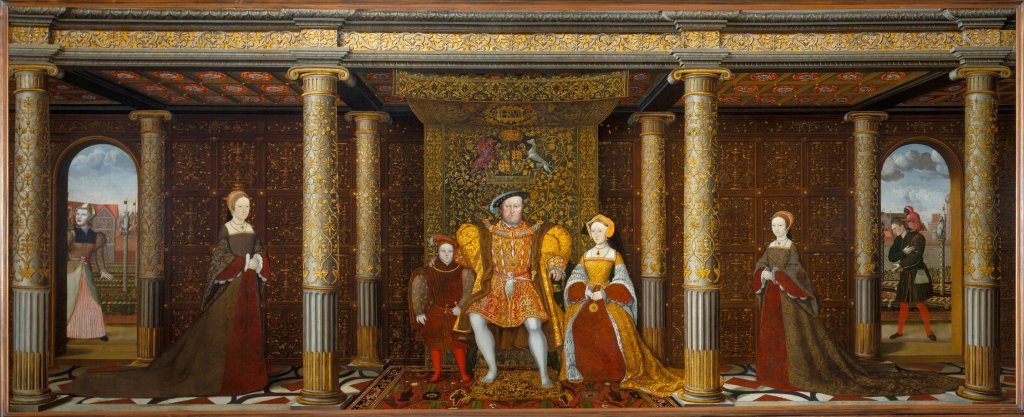The Tudor dynasty – Henry VII, Henry VIII, Edward VI, Mary I, and Elizabeth I – are perhaps the most famous monarchs in British history. And it’s easy to see why! Together, these monarchs’ histories encompass a narrative in which the personal and political mingle enticingly, creating something akin to a soap opera – but with meaning.
Henry VII rises from aristocratic origins and ancient royal blood to seize a kingdom. His son – his second son, not intended to rule – comes to the throne as a handsome young man, married to his brother’s widow in an apparently romantic story. Henry VIII grows to fear his lack of a son and throwing the entire kingdom into turmoil in order to get one and/or to be with the woman he actually loved. The frenzy of his marriages and remarriages, each with its own comprehensible narrative, followed by the accession of his only surviving son, who quickly follows him to the grave. (Brief pause for Jane Grey.) “Bloody Mary” reigns over a hostile country, unwilling to accept that the land is now Protestant. And then, of course, glorious Elizabeth comes to the throne to usher in a golden age of exploration, riches, and good governance.

These stories have been told and retold many times in English literature, film, and television, usually from angles that held some resonance for their contemporary audiences. Susan Bordo gives an excellent explanation of the way Anne Boleyn specifically has been interpreted in vastly different ways during different eras in The Creation of Anne Boleyn, but we can also see this with others. Mary can be presented as a rampaging, evil Catholic or a hurt and confused child of divorce; Henry can be a tyrant and villain or a rockstar.
From one angle, this is a very good thing. Not all history education happens in schools: we learn a lot through pop culture, from basic timelines to the names of individuals. The preponderance of Tudor-era fiction means that many more people have some idea about this period and the political and social struggles that occurred in it than they probably otherwise would. Imagine a world where the Tudors are treated like the Stuarts – figures mainly known only to people who actually care about the period, apart from a couple of facts like “Charles I got his head cut off, I think, and Charles II had a lot of mistresses?”
However, popularity has its own problems. Because these historical figures are mostly known from fiction, they’re treated almost as fiction. There’s a vicious cycle in which people become fans and develop impressions of the “characters” based on fiction, then seek out pop history works on the Tudors that confirm these impressions, then return to fiction armed with beliefs about which characterizations are historically accurate.
I’ve seen this tendency a number of times just on AskHistorians. The most blatant was in:
Why do some historians think Anne and Jane Boleyn are misunderstood?
First, with Anne, some say that her reputation of seductress and homewrecker is not earned because she never tried to get Henry’s attention. That Henry basically harassed her despite her lack of interest
This to me is foolish as it goes against EVERYTHING we know about Anne. We KNOW she impatiently waited to be queen, and we know she intentionally was horrible to current queen Catherine of Aragon and her daughter. Are we to assume she was uninterested and harassed into it and did a 180°?
Now to Jane. Some wanna say that she doesn’t deserve the allegations of being a toxic family member as there is no proof she testified against her sister in law Anne and her husband George
But this again makes little sense to me. Why? Because we KNOW she comes back to court as a lady in waiting to the next queens. There is no way she would be allowed to do that if she sided with Anne and George. The only way to explain why she wasn’t dragged along by Annes fall is she sided with the king and aided his goal of getting rid of her.
I went back and forth with this user in a chain of replies, and they never seemed to understand that their impression of what we “KNOW” of these women’s personalities represented “a #TeamAnne vs. #TeamKatherine shipwar” rather than good historical practice. Mix in presentist judgments like “toxic family member” and you have an excellent recipe for bad history.

And while this example was particularly egregious in how straightforward the other person was in identifying Tudor wives and relations as good or bad, it’s not actually that uncommon for people to refer to these figures as though they know them. As though they have a far better sense of their motivations and personalities than any historian could really vouch for.
With the size of the Tudor industry as it is, there’s no way to prevent this. I struggle with the same issue, because I’ve also participated in the Tudorsphere and have the same fiction depictions in my head. I suppose the best any of us can do is to keep in mind that we’re all susceptible to the effects of fictional depictions of history, especially when certain tropes are run into the ground in said depictions.
Leave a comment